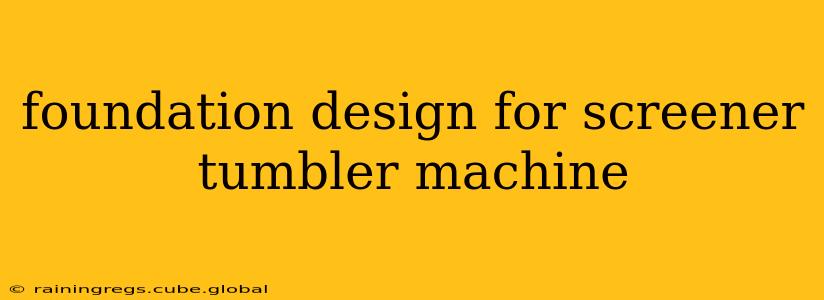Designing a robust and stable foundation for a screener tumbler machine is crucial for ensuring its smooth operation, longevity, and safety. A poorly designed foundation can lead to vibrations, misalignment, premature wear, and even catastrophic failure. This guide delves into the key considerations for designing such a foundation, addressing common questions and offering practical advice.
What are the key factors to consider when designing a foundation for a screener tumbler machine?
Several critical factors influence the foundation design for a screener tumbler machine. These include:
-
Machine Weight and Dimensions: The foundation must be strong enough to support the machine's total weight, including the materials being processed. Accurate weight and dimensional data are essential for proper design calculations. Consider future expansion or upgrades that might increase the load.
-
Vibration Levels: Screener tumbler machines generate vibrations during operation. The foundation must effectively dampen these vibrations to prevent them from transmitting to the surrounding structure and causing damage or noise issues. This often requires incorporating vibration isolation measures.
-
Soil Conditions: The type of soil beneath the foundation significantly impacts its design. Poor soil conditions necessitate deeper foundations or specialized ground improvement techniques to ensure adequate bearing capacity. Geotechnical investigations are often necessary.
-
Environmental Factors: Exposure to elements such as moisture, temperature fluctuations, and freeze-thaw cycles can affect the foundation's integrity. The design should account for these factors using appropriate materials and construction techniques.
-
Accessibility: The foundation should allow for easy access to the machine for maintenance, repairs, and replacement of parts. Consider space for lifting equipment and walkways.
What type of foundation is best suited for a screener tumbler machine?
The optimal foundation type depends on the factors mentioned above. Common choices include:
-
Reinforced Concrete Slab: A robust and widely used option, particularly for smaller and lighter machines. It offers good vibration damping and stability.
-
Reinforced Concrete Block Foundation: Cost-effective for smaller installations. Requires careful attention to leveling and grout filling to ensure stability.
-
Steel Structure Foundation: Suitable for larger, heavier machines or those operating in challenging soil conditions. Offers high strength and flexibility in design.
How do I calculate the required size and strength of the foundation?
Calculating the foundation's size and strength requires engineering expertise. The process typically involves:
-
Determining the machine's dynamic load: This considers not only the static weight but also the vibrational forces generated during operation. This requires specialized software and/or consultation with a structural engineer.
-
Analyzing soil conditions: A geotechnical investigation will determine the soil's bearing capacity and any potential ground improvement needs.
-
Selecting appropriate materials: Concrete strength, reinforcement type and size, and foundation depth are chosen based on load calculations and soil conditions.
-
Designing the foundation geometry: The size and shape of the foundation are determined to distribute the load effectively and provide adequate stability. This includes considering the machine's footprint and center of gravity.
What are common mistakes to avoid when designing a screener tumbler machine foundation?
Common pitfalls to avoid include:
-
Underestimating the dynamic load: This can lead to excessive vibration and premature foundation failure.
-
Ignoring soil conditions: Neglecting a geotechnical investigation can result in inadequate bearing capacity and settlement problems.
-
Using inappropriate materials: Selecting materials with insufficient strength or durability can lead to premature failure.
-
Poor construction practices: Improper construction techniques can compromise the foundation's integrity.
What are some vibration isolation techniques for a screener tumbler machine foundation?
Vibration isolation is crucial for minimizing the transmission of vibrations to the surrounding structure. Techniques include:
-
Using vibration isolation mounts: These are placed between the machine and the foundation to absorb vibrations.
-
Incorporating damping materials: Materials like rubber or neoprene can be incorporated into the foundation design to dampen vibrations.
-
Designing a flexible foundation: A foundation that is slightly flexible can help to absorb some of the vibrational energy.
In conclusion, designing a foundation for a screener tumbler machine requires careful consideration of several factors. Consulting with a structural engineer is highly recommended to ensure a robust and reliable foundation that meets all safety and performance requirements. A well-designed foundation will significantly contribute to the machine's operational efficiency, longevity, and overall cost-effectiveness.
